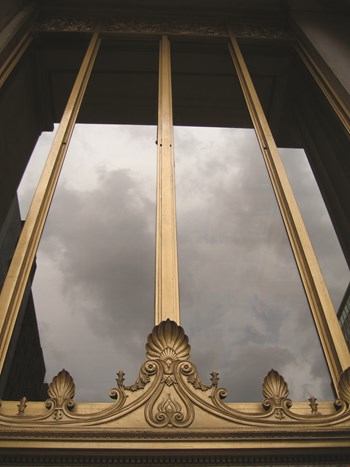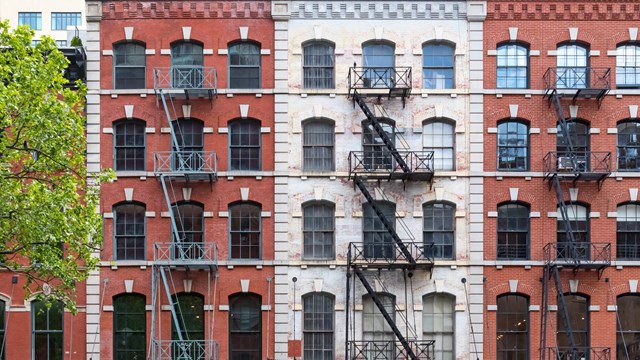
In New York City, a great source of pride equates from owning an apartment in a landmark building or living in one of the city’s historic or architectural masterpieces. Though, along with such ownership arise unique challenges involving repair and restoration. The process is controlled entirely by the Landmarks Preservation Commission (LPC), which rules over these protected structures often with an iron hand.
“You think you own your building…but you don't,” says Wayne Bellet, owner of Bellet Construction Company, a Manhattan-based exterior restoration contractor, in business for 96 years. “It belongs to the city. That is the hardest thing for me to express to people who want to hire me to do this work. The façade of your building is not your façade. It’s Landmark’s façade.”
Don’t Know What You’ve
Got Till it’s Gone
Scores of historic buildings were destroyed in the booms of the 1920s and post-World War II years, but after the demolition of the monumental Pennsylvania Railroad Station to make way for Madison Square Garden and Penn Station, an outraged citizenry finally cried “enough!,” leading to the creation of the Landmarks Preservation Commission, established by the Landmarks Law in 1965.
The LPC operates by granting landmark status to New York City’s architecturally, historically, and culturally significant buildings and enacting/enforcing regulations prescribing how owners of the properties must maintain them. Generally, this commission is concerned with building exteriors; there are more than 31,000 landmark properties in the city, most of which are in 111 historic districts in the five boroughs—with a huge majority in Manhattan—and only 117 interior landmarks.
According to the 1965 Landmarks Law, a structure or place worthy of landmark designation must be at least 30 years old and have, “a special character or special historical or aesthetic interest or value as part of the development, heritage, or cultural characteristics of the city, state or nation.”
Landmarks finds and adds buildings to its list of protected properties, and also reviews applications from citizens and interest groups. The number of buildings under its umbrella has more than doubled since 1990 when there were just 52 historic districts in the city, containing fewer than 15,000 buildings.
Are You a Landmark?
Most board members and managers know their building’s status, but with all the historical districts scattered throughout the city, some are surprised. Unless the building is newly opened, a board should ascertain whether it is a landmark before scheduling projects that affect the face of the building, no matter how minor. To be certain, enter the building’s address into the information search on New York City Department of Buildings’ website.
Now, for the fun part…getting approval for and working on a landmarked building. “It is no big deal…if you play your cards right,” according to John Tsampas, president of Skyline Restoration, one of the largest restoration firms in the city. That’s a big “if” with the Landmarks Preservation Commission monitoring your every move; really, you’ve got to play your hand impeccably.
Working with the LPC requires patience. The job could take considerably longer than a similar project on a non-landmark building. How much longer it takes depends on complexity and the amount of alteration. “When you look at the scope of what happens from the Department of Buildings’ point of view, it’s amazing anything gets built or maintained,” says Bellet. “Now, you sprinkle on the top of it that the building is landmarked, and that you have to maintain the original concept of the builder…it's not going to happen tomorrow.”
Bellet recommends starting the process in January, February or March. For unknown reasons, suddenly everyone decides to work on their buildings in spring or summer, flooding the Landmarks Preservation Commission with applications. “They are twiddling their thumbs,” come winter, he says.
Choosing Your Team
The process begins with choosing an architect plus an engineer for any significant repair or alteration, and a contractor. Each should be experienced in historic restoration, with at least five landmark projects in their portfolio and ideally, known and liked by the commission. The architect goes to work first, preparing the drawings Landmarks requires. Applications for a work permit on the exterior of any building in the city require architectural drawings detailing every aspect of the job. A landmark review is even more demanding.
In addition to reporting all materials to be used on the building and the methods that will be employed, the Landmarks Commission “wants to see mockups or samples of everything that's going to go on the building before they approve it,” according to New York architect Howard Zimmerman, whose firm does some 40 landmark projects a year. “A contractor would be instructed to build a section of wall to show the color of the mortar, the color of the brick or stone, the texture of the stone…everything to be built on the wall.”
The architect will be your expediter, pushing the application through the gauntlet of Department of Buildings and Landmark Preservation Commission approvals. Once the application is approved and the contractor begins, says Zimmerman, “we supervise the work to make sure that the contractor is doing the work in compliance with what our drawings show, and what Landmarks approved.” Ultimately the architect will sign off on the job, testifying that it was done in accordance with the drawings Landmarks approved.
Choosing your Contractor
Choosing a contractor experienced in historic restoration is essential, according to Joe DelGuidice, Jr., the head of World Wide Construction based in Ridgefield Park, New Jersey. “At the end of the day, if Landmarks isn't happy with something you are doing, they are going to make you do it over,” he says. No special certification is required to work on a landmark beyond the normal contractor’s license, but the firm should have relationships with suppliers of, and training in, the special materials you’re going to be using. Indeed, says DelGuidice, “Landmarks won't let you pull a work permit if you are not certified for the material they want you to use.”
“Regarding the historic parts of the building, the façade, what kind of materials you use, the marble, the brass, the terrazzo…Landmarks wants you to restore things according to how it was originally intended to be,” and to take pains to protect its often fragile coating, according to Lina Gottesman, president and owner of Altus Metal, Marble and Wood in Long Island City.
“You can't use certain types of harsh tools or products to do this,” she adds, “because you would damage the surfaces. There are very specific ways to deal with, let's say, metal in a historic situation versus on any commercial entrance.”
For example: “We try very hard not to remove any of the original patina on brass,” says Gottesman. “You want to retain the original patina, the original colors, as much as possible.” The Landmarks Preservation Commission demands that any patch or replacement must look exactly as it did when the structure was first built. This includes jobs as small as replacing or re-caulking window sills to re-pointing the façade and replacing damaged brick, stone, and mortar. “Landmarks will actually come out to the building, send a conservationist, examine the color of the mortar, the color of the caulking, and the color of the paint,” says Bellet.
Contractors experienced in historic buildings know where to get materials that match or craftsmen to custom make replacements. Most work with local suppliers because sometimes materials are sent back for fine tuning and must be replaced quickly. There is a lot of room for error in matching materials.
If, say, “Landmarks approves the sample and we go have it made and it comes back in the wrong shade of gray, or if the supplier mixed a little too much gray, not enough gray, they baked it too long…we’ve lost four months,” says Zimmerman. Custom-crafted replacement pieces, like a replica of a century-old cornice, will take more time. “I mean weeks…sometimes months,” says Bellet. On large projects representing a significant capital outlay, the board should consult with a conservationist specializing in the technical aspects of restoring historic buildings to maximize the chances of meeting Landmark’s standards.
Waiting for Approval
Sometimes, Landmarks delays a job. Working on a façade on a building on Riverside Drive, recalls Bellet: “We opened the masonry because the bricks were unsafe and had to remove them.” Although the sample bricks he presented to Landmarks were a perfect match, he claims, “We could not get them to say ‘go.’ The winter came, so I put cement in the wall and stuffed it with insulation,” but that wasn’t sufficient to protect the building—and its poor residents—from the cold. “That must've taken five or six months.”
The approval process becomes even more complicated if you want to change something on the façade, perhaps replace a decorative element with a more durable material. The engineer has to file an application for a variance to both the Building Department and the Landmarks Preservation Commission.
To argue the case, the engineer might show the commission photos of other buildings that have the same element and had received a variance, or claim the façade is not safe, but the building does not have the money for an exact replication. The building might, at least, be granted permission to make a temporary repair with the stipulation that they finish the proper job in five years, for example.
With every inch of real estate worth a fortune in New York City, some co-ops or condos with flat roofs contemplate adding an additional floor to the top of the building. Landmarks will allow it as long as none of the structure is visible from the street. “They will ask you build a frame and paint it orange with spray paint,” says Bellet. “They will go to extreme street corners to see if it is visible by the eye. If it is…they will decline you. They will permit you to move it back but you’ve got to amend the drawings,” and get it re-inspected.
The cost of making repairs on or restoring a landmark varies with complexity of the job. Zimmerman says, in his experience, the price is usually about 15-20% above the cost of a similar project on a normal building. In addition to controlling the restoration and alteration of buildings, Landmarks keeps a tight reign over the maintenance and cleaning of the facade. “The Landmark folks are very delicate on what you are approved to use,” explains Bellet. “The material has to be calibrated to the substrate you are using it on.”
“It's a longer cleaning process,” says DelGuidice. “You have to do it maybe four or five times versus once or twice. If you don't know what you're doing and you use something that's too acidic, you’re going to ruin the face of the existing masonry,” and in the process, facing serious penalties for defacing an historic landmark.
Just Do It
In the next few years, many buildings will need to inspect and repair façades, as will all buildings over six stories in the city, in compliance with Local Law 11, also known as the Facade Inspection Safety Program or FISP. Whenever possible, it pays to apply for and make repairs in advance, especially in a landmark with its complicated approval process, to beat the rush of other buildings against the same deadline (deadlines are staggered according to block numbers).
“At the last minute, when everybody's trying to finish everything,” says Zimmerman, “contractors, architects and engineers are raising their prices and materials take longer. If you can do it at a different time because of good planning, you can get a better job at a cheaper price.”
Steve Cutler is a freelance writer and a frequent contributor to The Cooperator.






Leave a Comment